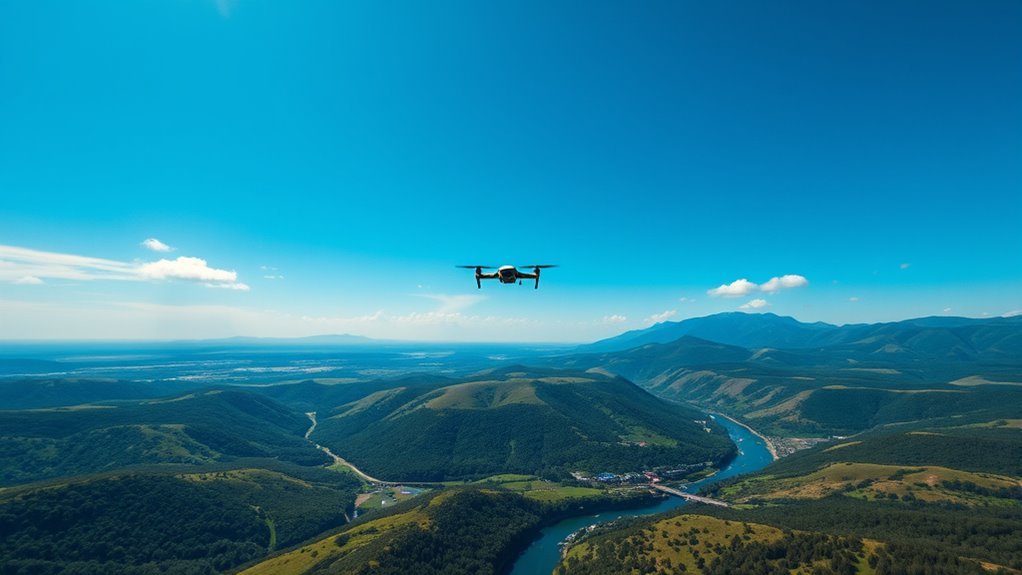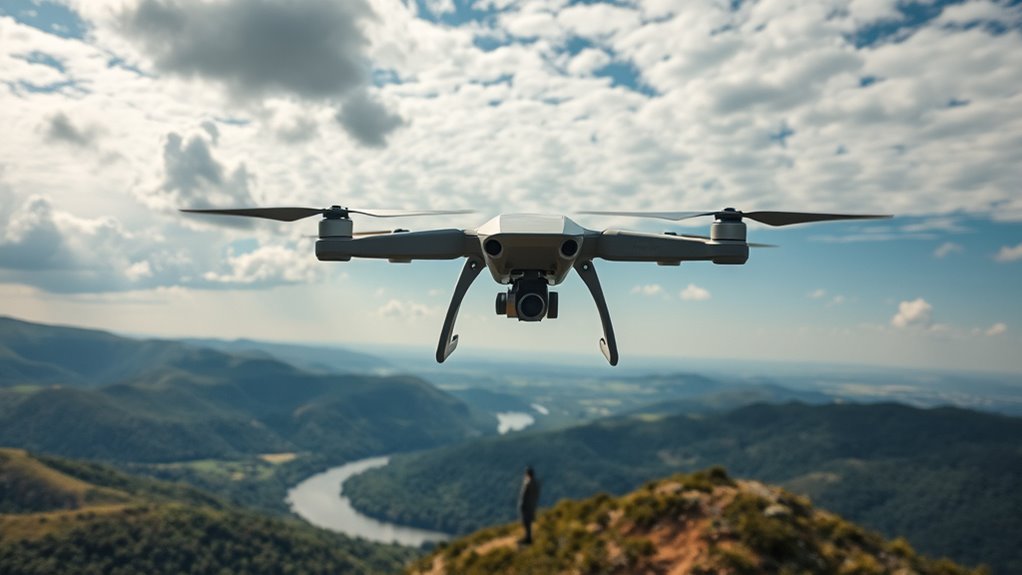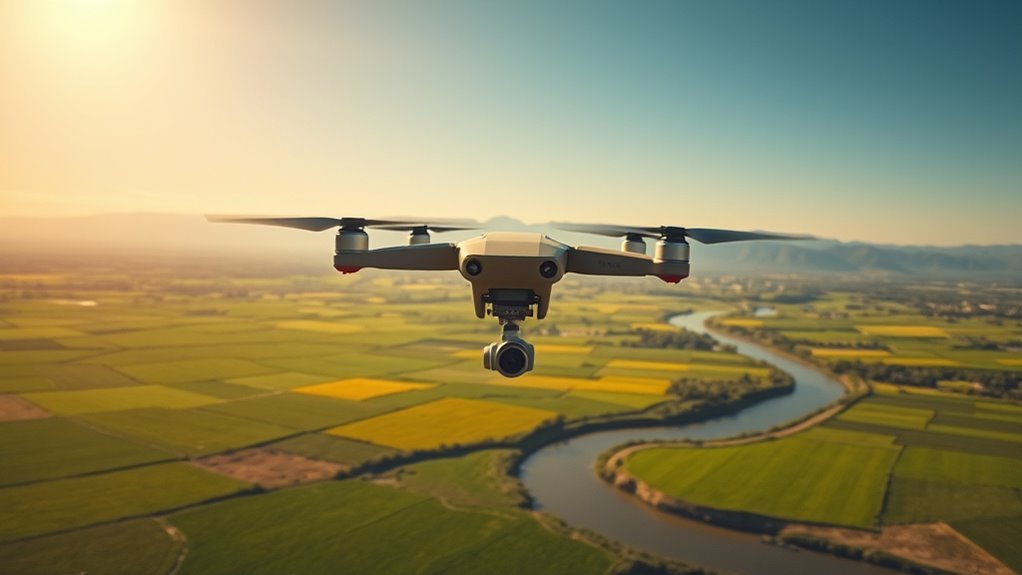Drones can fly impressive distances, varying from a few kilometers for consumer models to over 100 miles for fixed-wing drones. Their range depends on factors like battery life, communication technology, and environmental conditions. Payload weight and flight planning also play significant roles. High wind or rugged terrain can limit performance, while regulatory compliance guarantees safe operation. To optimize your drone’s distance capabilities, understanding these aspects is crucial. Explore the various influences on drone range further for better insights.
The Basics of Drone Range

Understanding the range of a drone is essential for effective operation and mission planning. The range directly impacts your ability to maintain drone communication, ensuring that control signals and telemetry data are transmitted without interruption. Different drones have varying range limitations, often dictated by their design, battery capacity, and communication technology. For instance, consumer drones typically operate within a few kilometers, while professional models can extend beyond thirty kilometers, provided they utilize advanced communication systems. Knowing these parameters allows you to strategically plan missions, ensuring your drone remains within a reliable operational zone. By grasping the basics of drone range, you empower yourself to maximize the potential of your aerial tools while adhering to regulations and maintaining control. Additionally, understanding battery capacity is crucial as it determines the total energy storage available for flight distance. Furthermore, advancements in long-range communication systems have significantly improved control over extended distances.
Factors Affecting Drone Distance

While various factors influence a drone’s operational distance, three primary elements stand out: battery life, communication technology, and environmental conditions.
| Factor | Effect on Distance |
|---|---|
| Battery Life | Determines flight time and energy |
| Communication Tech | Impacts signal strength and range |
| Environmental Conditions | Affects stability and performance |
Battery life directly correlates with how far you can fly your drone. As battery life decreases, the drone’s ability to maintain optimal performance is hindered, limiting its range. Communication technology affects signal strength, which can limit distance if compromised. Additionally, weight distribution plays a role; uneven weight can strain motors and reduce efficiency, limiting your drone’s range. Understanding these factors can help optimize your drone’s distance capabilities, allowing for a more liberating flying experience. Notably, the flight time of a drone, as seen in models like the Draganfly Vital Intelligence, can significantly enhance operational range during missions.
Types of Drones and Their Ranges

Different types of drones exhibit varying ranges, influenced by their design and intended use. Quadcopters, known for their maneuverability, typically range from 1 to 5 miles, depending on battery capacity and environmental factors. Their capabilities allow for stable hovering, making them ideal for aerial photography and inspections. In contrast, fixed-wing drones offer significant advantages in range, often extending from 10 to over 100 miles. Their aerodynamic design enables efficient long-distance flight, reducing energy consumption. While quadcopters excel in short, versatile missions, fixed wings are preferred for extensive surveying and mapping tasks. Understanding these distinctions helps you choose the right drone for your specific needs, balancing between the agility of quadcopters and the expansive reach of fixed-wing models. Additionally, payload weight limits play a crucial role in determining the effective range of drones, as exceeding these limits can compromise flight performance and safety. Moreover, managing battery life effectively can significantly enhance a drone’s operational distance, allowing for extended missions without frequent recharges.
Environmental Impacts on Flight Range
Although various factors influence a drone’s flight range, environmental conditions play a significant role in determining its performance. Weather conditions such as wind speed, temperature, and humidity can considerably impact battery efficiency and propulsion. High winds can increase drag, reducing your drone’s effective range and stability. Similarly, extreme temperatures may affect battery chemistry, leading to decreased flight times. Additionally, aerospace design is crucial for optimizing performance and mitigating the effects of these environmental factors. Terrain effects also matter; flying over rugged landscapes can require more power, limiting distance. If you’re maneuvering through hills or dense forests, the drone may need to expend additional energy to maintain altitude and stability, further curtailing its range. Understanding these environmental factors is essential for maximizing your drone’s performance and ensuring it reaches its intended destination. Implementing strategies like power management can help mitigate some of these challenges and extend flight distances under adverse conditions.
Regulatory Considerations for Drone Operations
Environmental factors greatly influence drone performance, but regulatory considerations also play an important role in operations. Understanding drone regulations and airspace restrictions is vital to guarantee both safety and compliance. Here are some key factors to keep in mind:
- Registration: Most drones over a certain weight need to be registered with aviation authorities.
- Flight Zones: Familiarize yourself with restricted airspace and no-fly zones to avoid penalties. Additionally, be aware of jurisdictional restrictions as they vary by country or region.
- Altitude Limits: Be aware of maximum altitude restrictions to maintain operational safety.
- Visual Line of Sight: Many regulations require you to keep your drone within your visual line of sight during flight.
- Local Laws: Check for any additional local regulations that might apply to your drone operations.
Adhering to these guidelines helps you operate freely and responsibly. Additionally, ensure compliance with specific flight restrictions to avoid legal consequences and ensure public safety.
Tips for Maximizing Your Drone’s Range
To maximize your drone’s range, focus on optimizing battery life, reducing interference factors, and utilizing high-gain antennas. Each of these strategies can markedly enhance performance and extend operational distance. By implementing these techniques, you’ll guarantee your drone operates efficiently over longer flights. Additionally, enhanced battery life can significantly impact how far your drone can fly before needing a recharge. Ensuring proper weight distribution is also crucial, as it minimizes energy waste and enhances overall flight efficiency.
Optimize Battery Life
While you might be enthusiastic to explore the skies with your drone, understanding how to optimize battery life is essential for maximizing its range. Effective battery maintenance and power management can considerably extend your flight time. Here are some tips to help you achieve that:
- Charge properly: Always use the recommended charger and avoid overcharging.
- Avoid extreme temperatures: Keep your drone and batteries within safe temperature ranges.
- Limit weight: Minimize additional payloads to reduce energy consumption.
- Plan your flight: Map out your route to avoid unnecessary backtracking.
- Use battery-saving modes: Enable eco or low-power modes when available.
Minimize Interference Factors
Minimizing interference factors is essential for ensuring that your drone achieves its maximum range, as various elements can disrupt the signal between your drone and its remote controller. To enhance communication stability, you should be aware of potential signal blockage from buildings, trees, or other obstacles that can weaken the connection. Always fly in open areas when possible, as this reduces the likelihood of interference. Additionally, avoid flying near strong electromagnetic sources, like power lines or radio towers, which can cause significant disruptions. Keeping your drone in sight not only maintains a clear line of sight but also allows for quick adjustments if you notice communication issues. By being proactive about these factors, you’ll maximize your drone’s operational range effectively.
Use High-Gain Antennas
Upgrading to high-gain antennas can greatly enhance your drone’s communication range and reliability. By selecting the right antenna types, you can experience considerable high gain benefits, allowing for longer flights and more reliable connections. Here are some tips for maximizing your drone’s range with high-gain antennas:
- Choose Directional Antennas: Focus signals in a specific direction for increased range.
- Consider Gain Levels: Higher gain often means better reception but may reduce coverage area.
- Use Quality Materials: Durable and lightweight materials can improve performance without adding weight.
- Positioning Matters: Verify antennas are mounted correctly for ideal signal transmission.
- Regularly Check Connections: Loose connections can greatly impact performance.
Implementing these tips can lead to a more liberating drone flying experience.
Frequently Asked Questions
Can I Extend My Drone’s Range With Modifications?
If you’re considering extending your drone’s distance, range boosters and antenna upgrades might do the trick. But, be cautious—modifications could compromise control and legality, so always prioritize precision and safety in your enhancements.
What Happens if My Drone Flies Out of Range?
If your drone flies out of range, you’ll experience signal loss, causing it to either hover or initiate an emergency landing. This guarantees its safety, but limits your control and freedom during operation.
Are There Drones With Unlimited Range?
Imagine a bird soaring endlessly. While no drones possess unlimited range, long range drones equipped with satellite connectivity can extend your reach considerably, allowing you to explore vast areas without the constraints of traditional limits.
How Do Battery Life and Range Correlate?
Battery life directly impacts range; higher battery capacity generally allows for longer flight times. If your drone’s flight efficiency is optimized, it’ll maximize distance covered, ensuring you can explore freely without constant recharging interruptions.
Can Weather Affect My Drone’s Operational Range?
Weather’s like a puppeteer, pulling your drone’s strings. Wind resistance can drag it back, while temperature effects impact battery efficiency. Both factors can greatly limit your drone’s operational range, so choose your flying day wisely.

